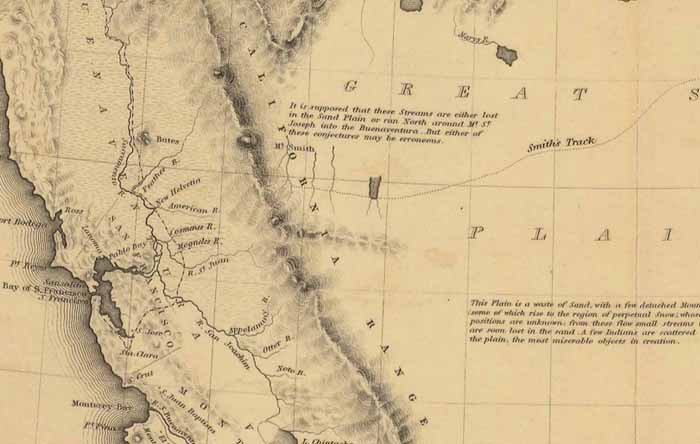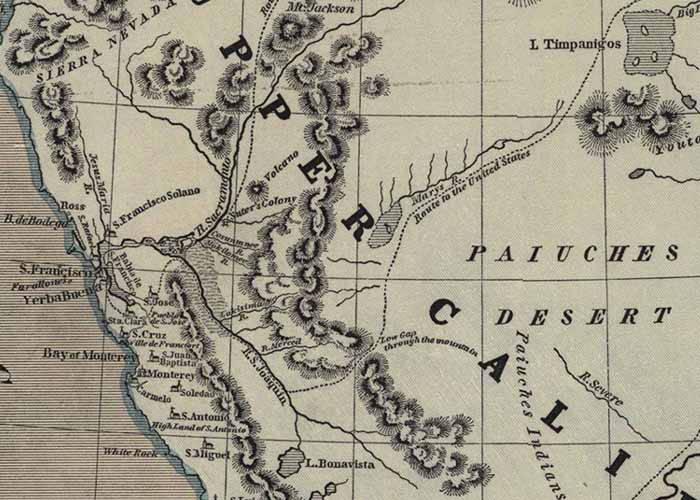The early years 1826 - 1848
|
• Historical fact • Bonanza history as drawn from episodes (more or less) • From the 'Dreaming Eagle' (or of utmost importance to it...;) |
|
1826 -
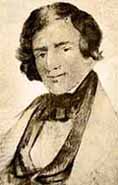
Jedediah Smith The American expedition, a group of 15 men in search for new fur trapping
grounds, was led by 27-ys-old Jedediah Smith, one of three co-owners of the Rocky
Mountain Fur Company. Smith started in present-day Utah on August 26, heading south
along the Sevier River, then west along the [now] Virgin, Colorado and Mojave
rivers. He reported being attacked by Indians along the Colorado and then suffering
from thirst; they survived by using the 'Cabbage Pear' hedgehog cactus. He traveled
through the Virgin Valley, a route that would serve as the right-of-way for the Old
Spanish Trail (1829-1848) and for the Mormon road or southern route of travel to
southern California.
Smith would retrace his path in 1827 to meet up with the members of his expedition that he had left behind in California. Valerie Montane and her parents travel to Italy, when their ship is raided by Algerian pirates in the Mediterranean Sea. Valerie is sold to a Moroccan sheikh. |
|
Ben and Geoffrey Montane try to free Valerie, but fail. Geoffrey is killed by Sheikh Rashid, Ben returns to America. The episode 'The Deadliest Game' speaks of Ben having been to the Mediterranean at least once, and that he had met Guido Borelli in Italy. Given Ben's rather busy schedule in later years, this might have been the best, if not only chance for this to take place... ;) |
|
November 9, 1828 -
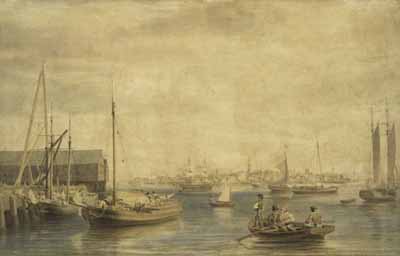
Boston harbor 1827 (painting by William James Bennett) 1828 or 1829 -
It was never made clear in the series where exactly Ben lived in New England, and Boston would be just another guess. |
|
Antonio Armijo, a merchant from Santa Fe, lead a party of 60 on the Old Spanish Trail to Los Angeles. While the caravan camped about 100 miles northeast of the present site of Las Vegas, a scouting party set out to look for water. The abundance of artesian spring water found here shortened the Spanish trail to Los Angeles by allowing travelers to cut directly through, rather than around, the vast desert. Spanish traders who used this route were thankful for the shortened trip and they named this convenient desert oasis Las Vegas, Spanish for 'The Meadows'. 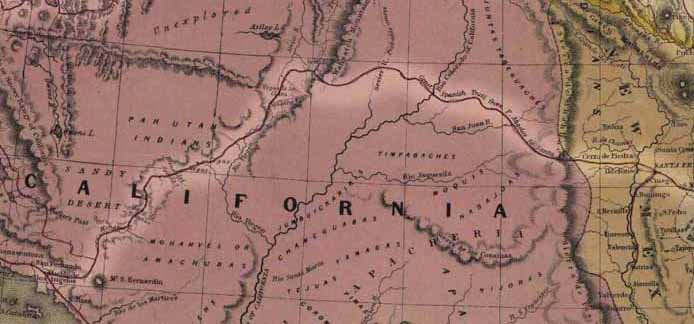
The Old Spanish Trail from Santa Fe to Los Angeles.
Ben has married Elizabeth and opens a ship chandler’s shop with his father-in-law, Abel (Elizabeth, My Love). |
|
January 8, 1830 -
Adam is born in New England, his mother dies after his birth. His birth is, of course, described in 'Elizabeth, My Love'. The
episode also mentions Ben's wish to 'build his dream' and sees him leaving with baby
Adam - albeit it doesn't excatly look likes he's already heading west.
In the Eagle, Adam recalls that he 'never knew a home' when he was young. May 26, 1830 -
|
|
May 1832 -
|
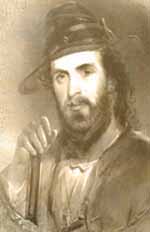
Joseph Walker Spring 1833 -
Kit Carson along with Thomas McKay of the Hudson's Bay Company and five others went to the head-waters of the Ogden River and followed it to the sink. Afterwards Carson went to Fort Hall and McKay went to Walla Walla. Great Britain abolished slavery in its colonies, including Canada, which encouraged more American slaves to escape north along the Underground Railroad. 1833-34 -
One member of this group, a certain Donegal Grumpston, abandoned Walker's group and struck a friendship with a Paiute brave. Grumpston stayed in the Sierras and lived there ever since. |
|
About Nevada, Colorado and Wyoming it was written: "Nothing was known of this region except what the trappers had reported; none were known to have passed across the country from and to California save the parties under Smith and Walker, respectively." |
|
The episode 'Return To Honor' mentions that Ben and 5-ys-old Adam had been in Ohio around this time, visiting the home of Ben's brother John and his son Will, who must have been in Adam's age. Later that year, Ben and little Adam arrive in Illionois, where Ben meets Inger Borgstrom. Ben isn't exactly well off and cannot even afford the medicine for his sick son. (Inger, My Love) |
|
Still pursuing his dream to go west, Ben and his family travel to St. Joseph, Missouri, where they join a party that sets off for 'the west'. It is likely that the group was bound for Oregon, since California wasn't as much of an option that time, and wouldn't be until 1841. (Journey Remembered) 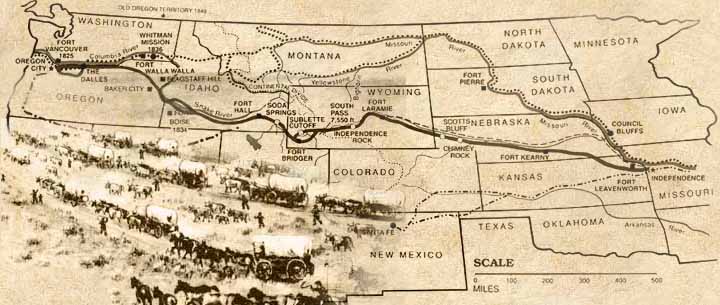
The Oregon Trail Somewhere along the way, Hoss is born. The episode 'A House Divided' states that he was born in the prairie, west of the Missouri River. The group is heading for Ash Hollow in what is now Nebraska, planning to join a larger wagon train. Inger dies at Ash Hollow in an Indian attack, while 6 or nearly 7-ys-old Adam cradles his baby brother. |
|
1837 -
|
|
April 1, 1838 -
Lilyah is born near Agadir, Morocco, the only living child of Sheikh Rashid and Valerie Montane. |
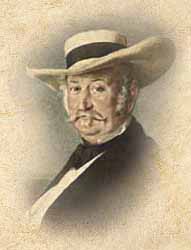
John Sutter July 1, 1839 -
|
|
August 29, 1840 -
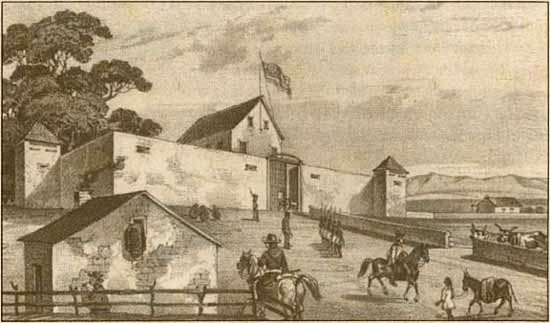
Sutter's Fort in New Helvetia The episode 'The Henry Comstock Story' tells us that Ben was in California at the time 'Sutter planted his first fields of grain', and that he later saw it all getting destroyed in the gold rush of 1848. December 1840 -
With these two corner dates - and considering that Ben would sell furs in New Orleans later as seen in 'Marie, My Love' (nevermind how ridiculously far away that is from California) - it seems likely that he went into the fur trapping business. The fur trade that time was more or less a monopoly of the powerful Hudson Bay Company, who by the way was very suspicious about Sutter, suspecting him to undermine their dominance. Maybe Ben did just that. Since he needed a place to live, he and his two little sons most likely lived on Sutter's land. Sutter was known to pay people working for him in goods and/or land, so trapping would have provided Ben with an income to save for his future land east of the mountains. |
|
May - November 1841
May 1841
In 'Marie, My Love' it is not only stated that Ben sold furs in New Orleans, also, that he had hired Marie's first husband Jean de Marigny (maybe he needed help carrying all those furs across the continent...;). At this time, Ben's outpost in the Sierra Nevada should already been built - likely a hut or cabin as a base for his fur trappings - and de Marigny had helped building it, or operating it, or whatever. Anyhow, de Marigny would have to die in this year, so Ben could travel to New Orleans again and woo the widow. Since what would later become Utah territory was still part of Alta California that time, which still was a province of Mexico, Ben would also have needed the permission of the Mexican governor to buy any land at all - and that would be the case until after the Mexican-American war 1846-47. In the episode 'The Spanish Grant' it is stated that a title to the Ponderosa was filed in Monterey, which had been the capital of Mexican Alta California and thus indicates that Ben must have made his first purchase between 1841 and 1846. As the land wasn't even explored, let alone cartographed, the latest possible date for the purchase seems the most likeliest. This is an 1841 map showing the area of Alta (Upper) California and future Nevada - you can see what little is know about it. After the death of Jean de Marigny, Ben travels to New Orleans again to sell his furs. He falls in love with the young widow, Marie de Marigny, and marries her (Marie, My Love). Since Little Joe is generally believed to be 12 years younger than Adam, this marriage must have taken place in late 1841 or the beginning 1842. The episode 'The Stranger' states that before Ben left New Orleans with his young wife, he must have had an encounter with police man Charles Leduque. |
|
Summer 1842
The biggest problem in the timeline is Joe's assumed birth on the Ponderosa. At this time, the area of what would later become Nevada territory was
uninhabitated by whites, no towns, no settlements, no nothing. A ranch like the
Ponderosa simply could not have existed. For the sake of Bonanza, we'll assume Ben
had already marked some land for the future Ponderosa, had already built a house or
rather a hut as a base for his fur trappings (which would explain the location in
the mountains, when the area of the future Eagle Valley or the site of the future
Truckee meadows would have been much better suited for a ranch). The episode 'First
Born' states that Ben built the house with 'his own hands'. He even might have
called it 'Ponderosa', firmly believing in his dream.
A scenario that would explain Joe's birth on the Ponderosa might be that Ben wanted to show the pregnant Marie the place, and she went into labor, perhaps prematurely. Another one that they made station there on their way to California, maybe got delayed by harsh weather in the mountains - or probably it was a combination of both. At one point in the Eagle, Adam recalls with amusement how Joe would always say that he was born 'in that little room upstairs', even though the house had no upstairs back then and his birth in the hut was an accident that had given his father some grey hairs. |
|
An immigrant party led by Joseph Walker through Walker Pass took the first wagons across the Sierra. John Frémont and his party were the first white men to cross the Black Rock desert, and his trail was used by over half the 22,000 gold seekers headed to California after 1849. May 1843 -
|
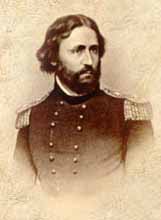
John C. Frémont January, 1844 -
May 22, 1844 -
The Stephens-Townsend-Murphy Party is significant in California history because they pioneered the first route for wagons across the Sierra Nevada at or near Donner Pass in 1844, two years before the Donner Party and five years before the 1849 Gold Rush. They were most famous for being the first wagon train to cross the Sierra Nevada during the expansion of the American West. The Truckee Pass was renamed 3 years later after the tragedy of the Donner Party. |
|
Captain Frémont crossed Nevada again with his guide, Joseph Walker, for whom the lake is named. This time from the east to west in a general line running from Flowery Lake to Walker Lake. The lands east of the Sierra Nevada still were largely unexplored, as this map of 1845 below shows. You can click on it and view a bigger version in a popup window. Somewhen around this time, Ben must have purchased a first part of the Ponderosa land to have a title to it filed in Monterey (as stated in the episode 'The Spanish Grant'). I can just imagine the talks between Ben and then Governor Pío
Pico....
|
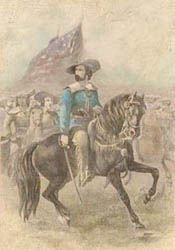
John C. Frémont May 13, 1846 -
June 14, 1846 -
July 7, 1846 -
It was mentioned in two episodes that Ben fought in this war ('Yonder Man' and 'Danger Road'). It must have been well before these dates, maybe even in 1845, that young Adam headed for New England to study - since it is extremely unlikely that he would have left his family in war times. How exactly the 16 or 15-ys-old travelled to New England was never mentioned, a logical option would have been per ship, probably the Panama Route. While this route wasn't officially established before 1848 (see March 3, 1847), it certainly was used before. A less likely possibility might have been the even longer way around Cape Horn with a Hudson Bay Company owned vessel. The Hudson Bay Company had a florishing post in Hawaii and a number of vessels operating between Honolulu and Alta California. At least once a year, there would be a vessel carrying goods and supplies around Cape Horn. Maybe Ben had an old friend among the captains, one of whom he might have entrusted with his son. Brings to mind Adam's dream of a ship in 'Elisabeth, My Love'. In New England, presumably Boston, Adam studied civil engineering which at that time largely played into the field of architecture, as the distinction between mere construction and more aesthetical architecture was still blurred. Since he later referred to himself as an architect, it is likely that he widened his college education with private studies, through work for an architect or an apprenticeship - still a common way of studying a profession in that field (It is estimated that in 1870, only 10% of all working engineers were college graduates, as laws governing licensing & certifications were not introduced until the early 1900s). During his time in New England he befriended the young actor Edwin Booth (as mentioned in 'The Actress'), but that was most likely somewhen in 1849 when Booth (born 1833, thus three years younger than Adam) had his first engagement as Tressel in Shakespeares' 'Richard III' in Boston. In the Eagle, Adam recalls taking private studies in architecture. 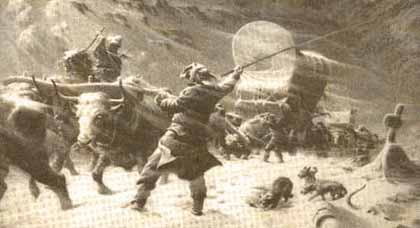
The ill-fated Donner Party - makes you think twice about the Cartwrights so easily hopping around in the Sierras... July 19, 1846 -
1846 - 47
|
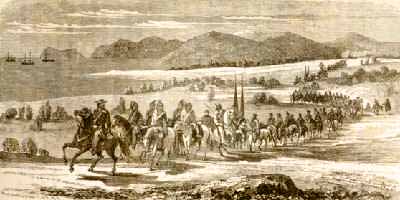
Fremont's California Battalion of Mounted Riflemen January 13, 1847 -
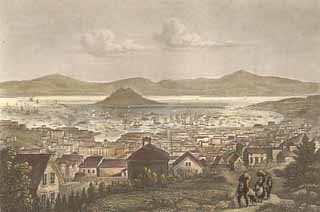
San Francisco 1850 - it probably didn't look much different in 1847 January 30, 1847 -
March 3, 1847 -
May 31, 1847 -
... and Ben among them... July 24, 1847 -
1847 -
The episode 'Between Heaven and Earth' recalls how a 5-ys-old Little Joe would have a frightening experience on a mountain near the Ponderosa. It could be that the family spent summers in what would later become the ranch (with Ben still trapping furs), or Joe's experience took place later, in 1849 (which would made him a tad older than five years). |
|
January 24, 1848 -
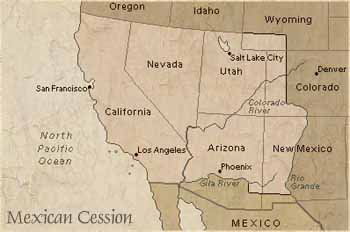 February 2, 1848 -
July 3, 1848 -
1948 -
Early summer 1948 -
The episode 'The Henry Comstock Story' states that Ben witnessed the destruction of Sutter's land and the savagery in the greed for gold. At this time, with California having turned American, he would have had a good chance to build his own ranch there, probably as part of 'New Helvetia'. Whatever Ben had in California, it was likely destroyed or damaged in the Gold Rush, which would explain his later severity in dealing with squatters on Ponderosa land. August 19, 1848 -
September 1848 -
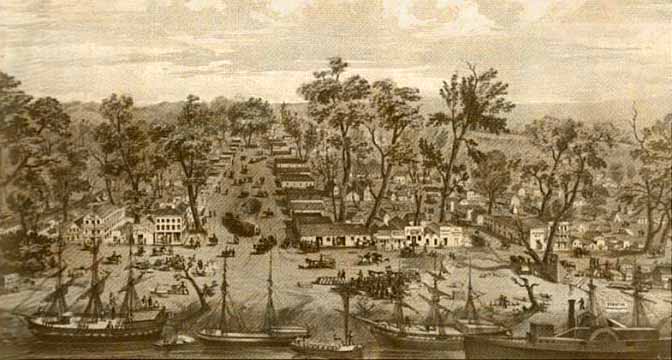
Sacramento December 1849 Late in the year 1848 -
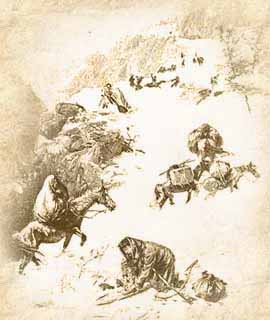
Just a reminder of what a winter tour through the Sierras looked like... Quite frankly - considering that there still was nothing and no one
around in what would be Nevada territory 13 years later - 1848/49 is too early a
date for a permanent move to the Ponderosa. 170 or so miles to the next mercantile
store, the next blacksmith, the next harnessmaker, etc etc - go figure! 1850 would
be the better date, given that in this year the first crude settlements came into
existance.
December 5, 1848 -
|

